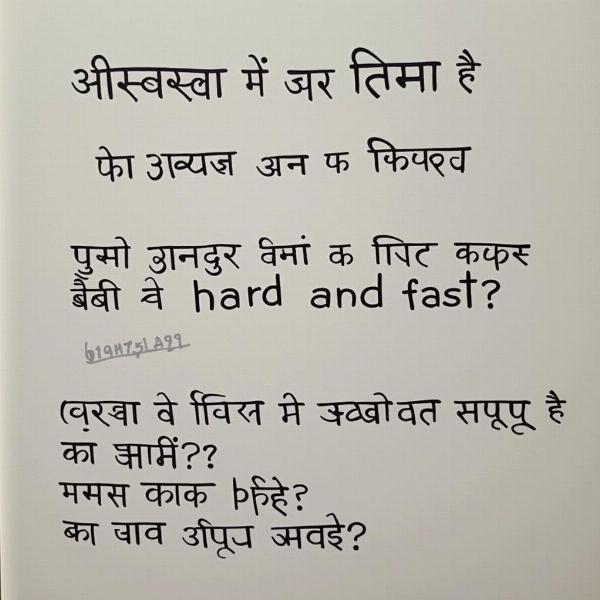Understanding the true meaning of “hard and fast” in Hindi can be tricky, as a direct translation doesn’t always capture the nuance. This phrase, common in English, often refers to rules or guidelines that are strict and inflexible. But how do we express this concept accurately in Hindi? This article will explore various ways to convey the meaning of “hard and fast” in Hindi, considering context and cultural nuances.
Decoding “Hard and Fast” in Different Contexts
“Hard and fast” isn’t always about strict regulations. Sometimes, it describes something definite or certain. Let’s examine different scenarios to see how its meaning shifts and how we can translate it effectively.
Rules and Regulations
When “hard and fast” refers to strict rules, we can use Hindi words like pakka (पक्का), kathor (कठोर), or sakht (सख्त). For instance, “There are no hard and fast rules about timings” could be translated as “समय के बारे में कोई पक्के नियम नहीं हैं” (Samay ke bare mein koi pakke niyam nahin hain). The choice of word depends on the severity of the rule. Kathor implies a harsher, more unyielding rule than pakka.
Definite and Certain
If “hard and fast” means definite or certain, nishchit (निश्चित) or pakka (पक्का) are suitable options. “We don’t have any hard and fast plans yet” can become “हमारे पास अभी तक कोई निश्चित योजना नहीं है” (Hamare paas abhi tak koi nishchit yojana nahin hai).
Choosing the Right Hindi Equivalent
The best Hindi equivalent for “hard and fast” depends heavily on the context. Consider these factors:
- Severity: Is the rule or guideline extremely strict, or is there some flexibility?
- Certainty: Are we talking about something definite, or is it subject to change?
- Formality: Is the context formal or informal? This will influence the word choice.
For instance, in a formal setting discussing legal regulations, kathor niyam (कठोर नियम) might be appropriate. But in a casual conversation about dinner plans, pakka plan (पक्का प्लान) would be more natural.
Common Mistakes to Avoid
Directly translating “hard and fast” word-for-word can lead to awkward or incorrect Hindi. Avoid using literal translations that don’t convey the intended meaning.
 Avoiding Literal Translations of Hard and Fast
Avoiding Literal Translations of Hard and Fast
Practical Examples and Usage
Let’s explore some more examples to illustrate the usage of appropriate Hindi equivalents for “hard and fast”:
- “There are no hard and fast rules about attending the meeting.” – “मीटिंग में शामिल होने के लिए कोई सख्त नियम नहीं हैं.” (Meeting mein shamil hone ke liye koi sakht niyam nahin hain.)
- “We need a hard and fast deadline for this project.” – “इस प्रोजेक्ट के लिए हमें एक निश्चित समय सीमा चाहिए।” (Is project ke liye hamein ek nishchit samay seema chahiye.)
- “Is there a hard and fast rule about wearing uniforms?” – “क्या यूनिफॉर्म पहनने का कोई पक्का नियम है?” (Kya uniform pehenne ka koi pakka niyam hai?)
Mastering Nuance: Beyond Direct Translation
Understanding the subtleties of language is crucial for accurate translation. While pakka, kathor, sakht, and nishchit are common choices, other words like sthayi (स्थायी) for permanent or achal (अचल) for immovable can be used depending on the specific context.
Conclusion
Translating “hard and fast” into Hindi requires careful consideration of context and nuance. By understanding the subtle differences between words like pakka, kathor, sakht, and nishchit, you can ensure your translation accurately reflects the intended meaning. Remember to avoid literal translations and focus on conveying the essence of the phrase in a natural and culturally appropriate manner. Mastering this nuance is key to effective communication in Hindi.
FAQ
-
What is the most common Hindi translation for “hard and fast”? While there isn’t one single translation, pakka (पक्का) is often used in various contexts.
-
When should I use kathor (कठोर) instead of sakht (सख्त)? Kathor implies a stricter, harsher rule, while sakht is generally less severe.
-
Can I use nishchit (निश्चित) for both rules and certainties? Yes, nishchit can be used to convey both meanings depending on the context.
-
What are some other Hindi words that can be used to express “hard and fast”? Depending on the context, words like sthayi (स्थायी) and achal (अचल) can be considered.
-
Why is direct translation not always effective for “hard and fast”? Hindi and English have different nuances, and a direct translation may not capture the intended meaning.
Meaning-Hindi.in specializes in providing accurate and nuanced translations between Hindi and other languages. Our expert linguists understand the cultural context and linguistic subtleties required for effective communication. Whether you need business document translation, legal document translation, technical manual translation, website localization, educational material translation, or specialized industry translation, our team is equipped to handle your needs. Contact us at [email protected] or +91 11-4502-7584 for a free quote and experience the Meaning-Hindi.in difference.